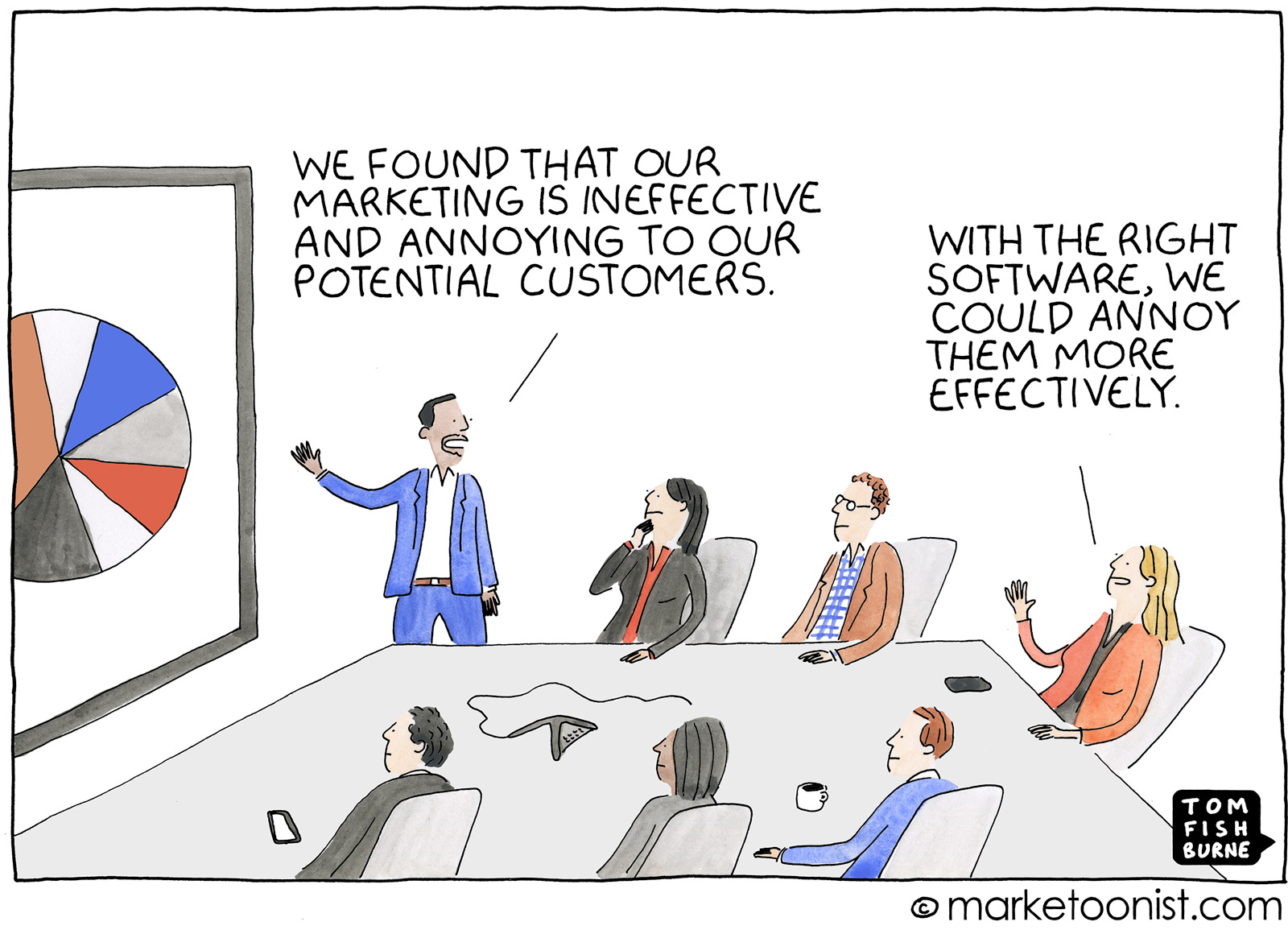Marketing, die, you vile, expensive, annoying thing!
Aren’t there those days when you yell, “Marketing, die, you vile, expensive and annoying thing!”
After which you vigorously kick a bucket…

Among tech businesses, marketing is one of the least understood (and probably least liked) pathways to increased growth and sales. (And measuring it can prove elusive…more on this later.)
If you’re not a marketer by trade, or even marketing-minded, it can seem daunting and otherworldly. Especially if you were expecting to slap up a website, create a few social media pages, and then, BOOM, watch the sales pour in while lounging on a brand new yacht sipping Italian espresso and canapes for breakfast. Right…
One of the hardest things about owning and running a company is making sense of how to proceed with sales and marketing. Especially, when it often feels like annoying customers is the only way to reach them.
How did customers get so good at ignoring us?
How did they get so good at avoiding us??
How did they get so immune to the benefits we’re trying to bring to them???
We’re just trying to help them!
Alright, simmer down. Remember, it’s not you.
Here’s the deal. We live in an increasingly noisy world. This is the normal response to an overly stimulating, yell-at-the-top-your-lungs, strobe light flashing society.
If you grew up with the circus, would it really be the circus to you? No. You’d probably say there’s no place like home while your mom double back flips off a trapeze while your dad is teaching the tiger how to dance.
And your brother? He’s just the family clown (both literally and figuratively).
So, the question becomes how do you, your company, your products and your services stand out in a circus? Especially if yelling, shaking, dancing, telling jokes and twirling tigers with your finger doesn’t work like it used to.
What else is there?, you may be asking.
Well, call it retro if you must but there’s always building relationships with your clients the good old-fashioned way (e.g. getting to know who they are and what they care about by having a back and forth conversation including asking questions and listening to their answers), which is ironically, pretty in fashion these days.
Good old-fashioned relationships (business and personal) are built on the following things:
- Listen to the other person’s pain points – what is causing them the most challenges and barriers in their current work?
- Validate their frustrations, grievances and feelings. Remind them they’re not crazy and they’re not alone. What they’re experiencing is very real, indeed.
- Encourage them to offer their own solutions – what do they think would solve their problems?
- Congratulate them on their insights and ask what they need most to move forward with their solutions or if they’re at a loss, ask if you can share what’s worked for you and/or other folks you know in similar situations.
Basically, approach them as you would a friend, with kindness, understanding and respect. Acknowledge that you know they’re intelligent people that have limited resources to fix a whole lotta complicated problems.
Treat them this way and you will get the chance to share how working with you (your products and services) could really benefit them by solving their problems and easing their pain.
BUT don’t get too old-fashioned. Though people may have consulted the phone book in the past and actually called you (some still do if the 50’s were their heyday), today’s customers are sophisticated and adept in the digital world. (If not, their 12-year old grandkid will help.)
Some of you may be intimidated by the thought of building real relationships with your clients.
Afterall, they all have busy lives too. Why would they make time for you?
To which I reply, because..
…Your Prospects Want To Hear From You!
Believe it or not, they really do! Who doesn’t want more real world problem-solving folks in their lives?
Here’s why. You make your clients more successful and reduce their stress by fixing things, which is an extremely valuable service in today’s society.
You’re so good at what you do that you’ve earned the right to brag about it (though only in the privacy of your own home).
Bragging, shouting and strobe lighting your services, no matter how good, is old school marketing. It no longer works. There’s more noise out there than ever and most folks are adept at the fine art of tuning it out.
Today’s marketing is based on being a guide to your client’s success and in relationship building. Think more in terms of intimate conversations in a quaint coffee shop about their pain points vs paparazz-ing your clients 24/7 with your message.
Now that I’ve drilled into you how important the relationship building aspect is, your clients and prospects need to be able to find you!
How do you make it easier for clients and prospects to find you? Below are three ways to do it right:
1. Tell Your Buyers You Actually Exist!

Your first priority is to get the word out about your technology business using a holistic approach. Don’t be the star athlete that skips cardio in favor of intense strength training.
Muscles aren’t the only things that matter, longevity does too!
And just as you wouldn’t invest your whole retirement in one business or account, don’t concentrate all of your marketing in one place. Marketing is a constantly, shape shifting landscape so it needs to be multi-faceted.
It’s important to build a strategy that includes multiple, collaborative components such as combining your offline marketing efforts (like direct mail) with your online marketing efforts.
If you’re a B2B technology business, and already know who your ideal buyer is, use these three TOP tactics to target them. (If you aren’t sure who your ideal buyer is, we’ll show you how to figure it out in a later email.)
1. Email marketing: Despite what you’ve heard, email marketing is NOT dead. Emails very much alive and kicking. And despite what you might think, your ideal buyers WANT to connect with you and they still rely on email.
Actually, there’s no better place to reach them than their inbox. This is where they spend the majority of their time going through an average of 90-126 emails a day.
So, unless you’re going to surprise them with your message at their favorite coffee shop or sneak into their house at night (NOT advised), your surest bet to find them is via email. Now, you might be wondering how to stand out in a crowded email inbox.
The answer, our friends, is through compelling and engaging content (additional bonus points if it’s funny).
(Pep Talk sidenote: You are doing your clients and prospects a favor by reaching out to them. You really have valuable products/services/solutions to offer them that will make their professional lives better. And who doesn’t love the service-centric person who solves their problems? Just remember to focus on being the humble servant guide and your email will be the one they actually respond to.)
2. Social media marketing: Social media marketing is about socializing and branding. Notice that you don’t see the words, “sell things”, included in the previous sentence. In fact, please do NOT try to B2B sell on LinkedIn, Facebook, or Twitter.
That’s for the B2C crowd (yoga leggings, anyone?), When it comes to B2B and social media, it’s all about being authentically human with your prospects. This isn’t the time or place to brag, profess perfection, act like a know-it-all.
Act like this and you’ll always be picked last (or not at all) on the playground. Instead, use social media to demonstrate that you’re trustworthy and credible. Show who you are and what you’re about via photos and short-form videos. Again, avoid the sales pitch. Wrong time, wrong place, okay?
Lastly, keep in mind that social media is a LONG game Return on Investment (ROI) strategy. It takes consistent effort and time to build an online community and devoted followers for your offerings. But, don’t let this be last on your list, as it is a vital component of a comprehensive approach to marketing.
3. Search Engine Optimization (SEO): SEO is like an alien spaceship landed in the middle of town. Nobody seems to understand what it’s doing there but we’re all convinced of its importance.
Furthermore, why is it that most conversations with SEO experts typically go from targeting keywords to analyzing trends to blahbety blah blah blah in less than 2.5 seconds? (Insert glazed over eyes here.) Bad news: there is a learning curve when it comes to SEO.
Good news: you can learn how to do it.
We love breaking down SEO so it’s understandable and as painless as possible. Our winning process that proves itself time and time again includes:
- Claiming and properly setting up the Google My Business listing.
- Submitting the website and assets to the right 10-20 directories, 1-2 times a year.
- Using business specific, compelling organic content in all marketing efforts and reviewing and optimizing it annually.
- Creating a keywords list via a keyword exercise.
Have your eyes glazed over? Okay, no worries. We’ll dig deeper into how to tame and ride SEO like a champ in a future email.
2. Treat Words Like They Matter (Because They Do)!

The most important players in marketing are words, aka copy, aka content. Bad content equals radio silence equals no second date equals doubting the excellence of your products and services.
So, if you’re not a writer, plan to spend your marketing budget on generating compelling and engaging content.
Basically, successful marketing depends heavily on showing your target buyers how your products, services and solutions will solve their problems in a compelling and engaging way.
From clear and concise content, to keywords, to impossible-to-ignore call-to-actions, the right words make all the difference to getting that second date to maintaining product/service confidence to getting that sale.
3. Get Creative and Grow Those Leads!
Assuming that you’ve outlined a comprehensive digital marketing approach and have your message dialed in, it’s now time to focus on acquiring more leads in creative ways.
Try hosting webinars, organizing live or virtual events, trying out direct LinkedIn prospecting, deploying fun giveaways, launching referral programs, joining online groups, and even engaging influencer marketing.
So now we’ll touch on the ultimate question of all time…
What is the Best Way to Market Your Company?
Remember those times when telling the truth was very uncomfortable but you did it anyway because that’s the right thing to do? Now is one of those times. The truth is: it depends.
ARGHGHGH! Shake it off and stay with us here. You’re so close to the top of this mountain!
Successful marketing often requires trial and error since it depends on a number of variables. So don’t be afraid to try new things.
It’s like pasta. The only way to know if it’s cooked is to throw it against the wall and see if it sticks. However, if you employ the above tactics, you’ll shorten the time it takes to figure out the best way to cook your pasta.
Remember, there is no one-size-fits-all “best approach” to marketing your business and this is a good thing!
So let’s say that you’re gotten the word out, created compelling content but are still struggling in growing your leads. It’s time to focus on how to get your products and services in front of the right folks who desperately need them!
This is where strategy comes in.
Though strategy’s importance deserves way more space than we’re going to give it here, we want to give you some quick tips on connecting with your current and ideal future clients.
First of all, talk to them. That’s right. Approach your clients as if you were an anthropologist.
Go ask them what their biggest barriers, challenges and pain points they’re facing. Observe them, their facial expressions, the words they use, their daily lives. See and experience the world from their perspective and integrate your learnings.
Then, once you understand them more intimately, encourage them to imagine a world where their problems are fixed. Ask them to consider a better way.
Finally, step in and offer to serve as their guide along this better way. Help them to experience the benefits of your products, services and solutions.
Treat them with humility and respect. Continue to listen to them. Demonstrate your dedication in getting them to the other side – from problem to solution, from soul sucking stress, to more productivity, from anxiety headaches to more fun time with family and friends.
Even though you are bringing good changes, clients may resist so continue to support them throughout the process while addressing any challenges and pointing out all the positive progress they’ve made along the way.
Got Marketing Questions? We can help.
By clicking this button, you submit your information to Scott Growth Strategies, who may use it to communicate with you regarding this and other services.
